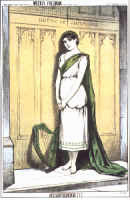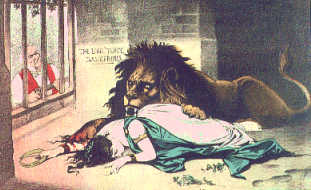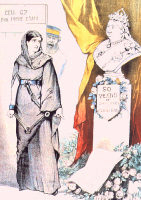
Jenny Mitchel

'Speranza'
Women were often informally involved in political activities in the past. They promoted male candidates and political issues by holding entertainments, fund-raising and canvassing. Sometimes women were bribed to encourage their husbands to vote in a particular way. They were not admitted to full membership of political organisations until the twentieth century.
Observers usually expressed surprise as they recorded how some women took part in episodes of group violence such as the murder of two tithe proctors during the tithe wars in Cork in 1833. In times of hunger, women, especially poor women, took part in election mobs and food riots and occasionally led the way in riotous behaviour.
| For example, a reporter at an election riot in Cashel in 1865 noted '... a fearful scene ... where well-looking, well-dressed girls, one a perfect Amazon, bared their arms, wound their shawls tightly around them and rushed with the mêlée.' Maria Luddy, 'Women and politics in nineteenth century Ireland' in M.G. Valiulis & Mary O'Dowd, Women & Irish history, Dublin 1997, p.92. |
The spirit of the times prescribed man's place as the public world of work and politics, while woman's place was in the home. In nationalist imagery, men would fight to defend female Ireland from the 'outsider', especially England which was often represented as a male aggressor. Propagandists also urged mothers to nurture ideals of patriotism in the nation's children and when men were slow to move, action threatened by women might be used to shame men into 'proving themselves men.'
| Women supporters of Young Ireland in the mid nineteenth century, wrote for the Nation newspaper under pen-names. 'Mary' was Ellen Downing. 'Eva' was Mary Kelly who later married Young Irelander Kevin Izod O'Doherty. 'Speranza' was Jane Francesca Elgee who married William Wilde and was mother of Oscar Wilde. Male writers sometimes concealed their identities behind female pen-names. |  Jenny Mitchel |
| Some women in the nineteenth century set up their own independent groups. Others assisted men's organisations in an auxiliary role. An article in The Nation, reflected a common opinion: |
|
| The world says, too, that 'women are not to meddle in politics'; and if by this is meant meddling publicly, the world is right. This is not a woman's sphere, and we should more deeply regret to see her so 'unsex' herself, than we now deplore the unfulfilled duty which is in her province ... A woman's sphere is in her home, her school, her fireside, where she has all holy things to teach. Article from The Nation quoted by Brigitte Anton in 'Women of The Nation' in History Ireland, Autumn 1993, p.36. |
A Ladies' Committee worked from 1865 until 1872 to aid families of imprisoned Fenians. Women were encouraged - and encouraged others - to purchase Irish goods and boycott British goods. A Fenian Sisterhood was formed in America with three hundred branches. It was mainly composed of Irish domestic servants who raised funds for the Fenians.
At a huge demonstration in Drogheda in August 1869 for the release of Fenian prisioners:
| ... women had their bonnets trimmed in green, or their hair bound in the national colour. From their necks flowed thin stripes of green silk, in almost every instance some portion of their dresses was rendered conspicuous by the introduction of the prevailing colour. The Banner of Ulster, 24 Aug. 1869 quoted in Maria Luddy, Women in Ireland 1800-1918, Cork, 1995, p.250. |
Gender difference was used in all kinds of ways. Female symbols were frequently used in nationalist propaganda. Ireland might be personified as a spirited young woman resenting domination and tolerating no nonsense from oppressive Britain. At other times Ireland was represented as a vulnerable and helpless female
Images of Erin in the days of Parnell
Can Erin beat off the vampire bat of British rule? Irish Pilot, Nov. 1885 |
 Suspense! Erin awaits the result of the debate on Home Rule in the House of Commons Weekly Freeman, May 1886 |
 Erin in the Tory lion's den. Gladstone peers through the bars. Can he come to her rescue? Weekly Freeman, July 1887 |
 '50 years of prosperity & gentle rule' for Queen Victoria - Cell 87 for Miss Erin Weekly Freeman, June 1887 |